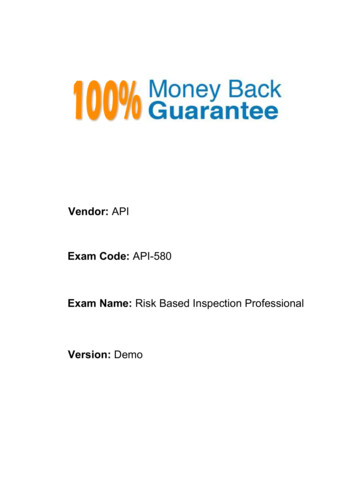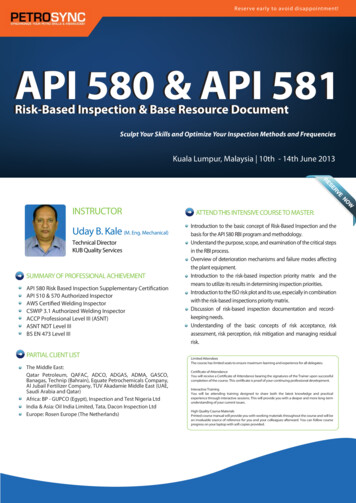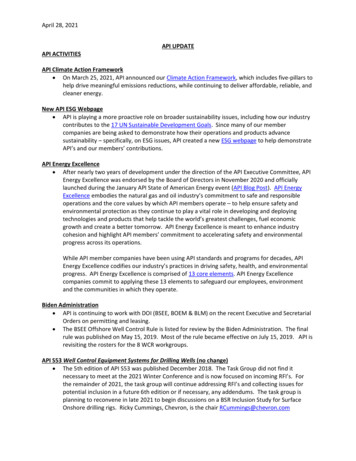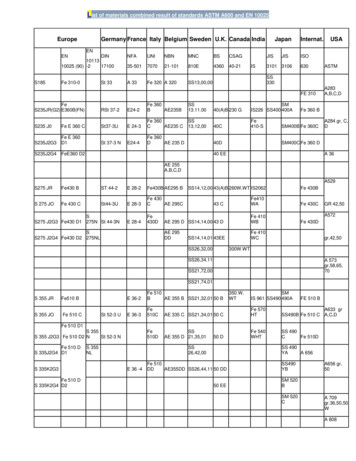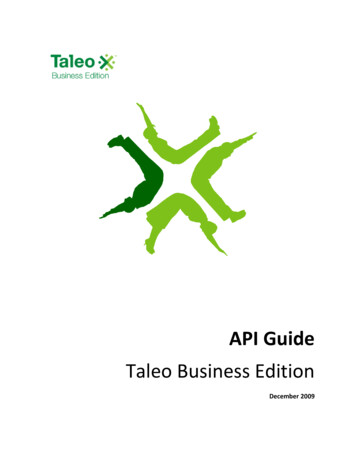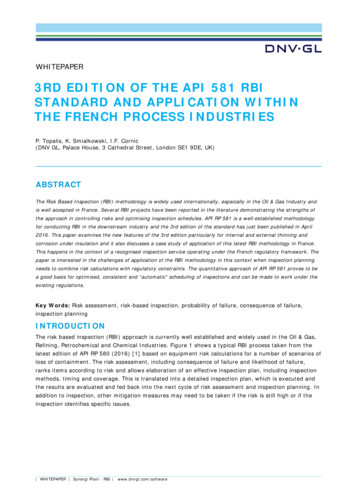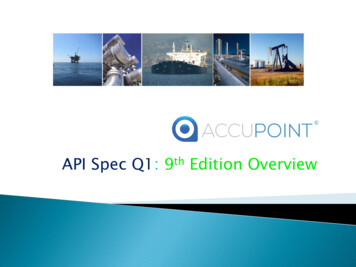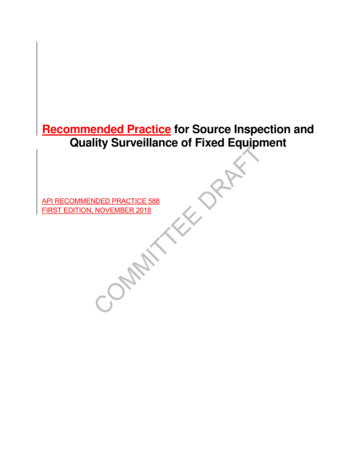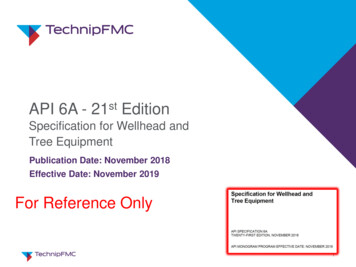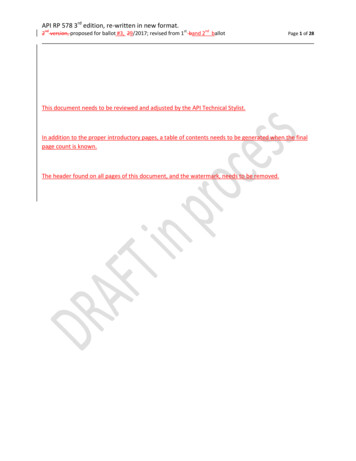
Transcription
API RP 578 3rd edition, re‐written in new format.2nd version, proposed for ballot #3, 29/2017; revised from 1st band 2nd ballotPage 1 of 28This document needs to be reviewed and adjusted by the API Technical Stylist.In addition to the proper introductory pages, a table of contents needs to be generated when the finalpage count is known.The header found on all pages of this document, and the watermark, needs to be removed.
API RP 578 3rd edition, re‐written in new format.2nd version, proposed for ballot #3, 29/2017; revised from 1st band 2nd ballotPage 2 of 28Guidelines for a Material Verification Program (MVP) for New and ExistingAssets1. SCOPE1.1. PurposeThe purpose of this recommended practice (RP) is to provide the guidelines for the owner/user todevelop and implement a material verification program (MVP) as part of an asset integrity program.The MVP uses positive material identification and other methods to verify that the nominalcomposition of an asset, an asset component, or weldment within the pressure envelope isconsistent with the selected or specified construction materials. .A well designed and implemented MVP is an important management system tool used to minimizethe potential for release of hazardous materials substances due to nonconforming materials ofconstruction.1.2. About this DocumentThis RP provides the guidelines for material verification programs involving ferrous and non‐ferrousalloys during the construction, installation, maintenance, and inspection of new and existing processequipment. This RP applies to metallic materials purchased for use either directly by the owner/useror indirectly through vendors, fabricators, or contractors and includes the supply, fabrication, andinstallation of these materials.This Recommended Practice is applicable to all oil and petrochemical processing systems, and maybe applied elsewhere at the discretion of the owner/user. It is intended to be applied by anyowner/user wishing to verify and/or validate that the materials of construction received, fabricated,and/or installed are in accordance with material specification(s[JLY1]).2. REFERENCES2.1. NormativeThere are no documents considered to be normative following referenced documents areindispensable for the application of this document. A bibliography is shown in Annex B. Fordated references, only the edition cited applies. For undated references, the latest edition of thereferenced document (including any amendments) applies. API 510, Pressure Vessel Inspection Code: In‐service Inspection, Rating, Repair, andAlteration API 570, Piping Inspection Code: Inspection, Repair, and Rerating of In‐service PipingSystems
API RP 578 3rd edition, re‐written in new format.2nd version, proposed for ballot #3, 29/2017; revised from 1st band 2nd ballotPage 3 of 28 API Recommended Practice 572, Inspection Practices for Pressure Vessels API Recommended Practice 574, Inspection Practices for Piping System Components API Recommended Practice 575, Guidelines and Methods for Inspection of ExistingAtmospheric and Low‐pressure Storage Tanks API Recommended Practice 576, Inspection of Pressure‐Relieving Devices API Recommended Practice 577, Welding Inspection and Metallurgy API Recommended Practice 751, Safe Operation of Hydrofluoric Acid Alkylation UnitsAPI RP 939‐C, Guidelines for Avoiding Sulfidation Corrosion Failures in Oil Refineries2.2. InformativeThe following referenced documents are informative in the application of this document. Fordated references, only the edition cited applies. For undated references, the latest edition of thereferenced document (including any amendments) applies. API RP 571, Damage Mechanisms Affecting Fixed Equipment In the Refining IndustryAPI Recommended Practice 580, Risk‐Based InspectionAPI 579‐1/ASME FFS‐1 Fitness‐For‐ServiceAPI Recommended Practice 751, SafeOperation of Hydrofluoric Acid Alkylation UnitsAPI RP 939‐C, Guidelines for Avoiding Sulfidation Corrosion Failures in Oil RefineriesASME1 Boiler and Pressure Vessel Code: Section II Materials (Part A: Ferrous Material Specifications,Part B: Nonferrous Material Specifications,Part C: Specifications for Welding Rods, Electrodes, and Filler Metals,Part D: Properties ‐ Materials)ASME PCC‐2, Repair of Pressure Equipment and PipingASME B31.3, Process PipingCSB2 Chemical Safety Board Bulletin 2005‐04‐B, “Positive Material Verification: PreventErrors During Alloy Steel Systems Maintenance”NACE3 Paper No 03651, “Specification for Carbon Steel Materials for Hydrofluoric AcidAlkylation Units”PFI42 ES22, Recommended Practice for Color Coding of Piping 1ASME International, 3 Park Avenue, New York, New York 10016‐5990, www.asme.org.2U.S. Chemical Safety and Hazard Investigation Board, Office of Prevention, Outreach, and Policy, 2175 K StreetNW, Suite 400, Washington, D.C. 20037‐1848, 202‐261‐7600, www.csb.gov. Most CSB publications are posted on,
API RP 578 3rd edition, re‐written in new format.2nd version, proposed for ballot #3, 29/2017; revised from 1st band 2nd ballotPage 4 of 28and can be downloaded from the CSB web site, http://www.csb.gov/safety 3NACE International , 1440 South Creek Drive, Houston, Texas 77218‐8340, www.nace.org.4Pipe 2Pipe Fabrication Institute, 511 Avenue of the Americas, #601, New York, New York 10011. www.pfi‐institute.org.3.0 DEFINITIONS AND ACRONYMS3.1 Definitions3.1.1 Alloy Material ‐ Any metallic material (including welding filler materials) thatcontains alloying elements, such as chromium, nickel, or molybdenum, whichare intentionally added to enhance mechanical or physical properties and/orcorrosion resistance. Alloys may be ferrous or non‐ferrous.3.1.2 Asset – piece or pieces of equipment working to manufacture products resultingfrom the processing of raw materials; hydrocarbons or chemicals within thecontext of this document.3.1.3 Distributor ‐ A warehousing supplier for manufacturers or suppliers of materialsor components.3.1.4 Extent of examination ‐ The specified percentage of the number of items to beexamined in an inspection lot.3.1.23.1.5 Fabricator ‐ An organization which utilizes the materials of construction affectedby this recommended practice in order to create an asset.3.1.3 Fabricator – An organization which builds the assets affected by thisrecommended practice3.1.43.1.6Heat ‐ A batch of metal made at the same time, able to be traced fromits original constituents and manufacturing process.3.1.53.1.7Inspection Lot ‐ A group of items or materials of the same type from acommon source from which a sample is to be drawn for examination. NOTE:An inspection lot does not include items from more than one heat.3.1.63.1.1Extent of examination ‐ The specified percentage of the number ofitems to be examined in an inspection lot.3.1.73.1.8Lot size ‐ The number of items available in the inspection lot at the timea representative sample is selected.3.1.83.1.9Material Certifications, or Certificates of Compliance[JLY2] – see mill testreport3.1.93.1.10Material manufacturer ‐ An organization that performs or supervisesand directly controls one or more of the operations that affect the chemicalcomposition or mechanical properties of a metallic material.3.1.103.1.11 Material nonconformance ‐ A positive material identification (PMI)result that does not conform with material specified.3.1.113.1.12 Material supplier ‐ An organization that supplies material furnished andcertified by a material manufacturer, but does not perform any operation
API RP 578 3rd edition, re‐written in new format.2nd version, proposed for ballot #3, 29/2017; revised from 1st band 2nd ballotPage 5 of 28intended to alter the material properties required by the applicable materialspecification.3.1.12 .3.1.13 Mill Test Report (MTR) ‐ A is a quality assurance document used in thesteelmaking industry that certifies a material's compliance with appropriatestandards, including physical and chemical specifications, and applicabledimensions. The MTR also includes a date of production and testing, and mayinclude notation about method of fabrication. A mill test report is also knownas: Certified Mill Test Report, Certified Material Test Report, Mill Test Certificate(MTC), Inspection Certificate, Certificate of Test, and by other names. However,MTR is the term that is used in this document.3.1.14 Owner/user ‐ The organization that exercises control over the operation,engineering, inspection, repair, alteration, pressure testing, and rating of thepiping assetssystems.3.1.15 Pressure‐containing components ‐ Items that form the pressure‐containingenvelope of the equipment and/or piping system.3.1.16 Positive Material Identification (PMI) ‐ A physical evaluation or test of a materialperformed to confirm that the material which has been or will be placed intoservice is consistent with what is specified by the owner/user. These evaluationsor tests may provide either qualitative or quantitative information that issufficient to verify the composition.3.1.17 Random ‐ Selection process by which choices are made in an arbitrary andunbiased manner.3.1.18 Representative sample ‐ One or more items selected at random from theinspection lot that are to be examined to determine acceptability of theinspection lot.3.1.19 Standard reference materials ‐ Sample materials for which laboratory chemicalanalysis data are available and are used in demonstrating the accuracy andreliability of a test instrument.3.1.193.1.20 Weld Button (button): a sample of welding filler material deposited onrelevant base metal in order to provide basis for PMI of the filler.3.2 AcronymsAPIAmerican Petroleum InstituteASMEAmerican Society of Mechanical EngineersLOQLimit of QuantizationMTRMill Test ReportMVPMaterial Verification Program
API RP 578 3rd edition, re‐written in new format.2nd version, proposed for ballot #3, 29/2017; revised from 1st band 2nd ballotNACENational Association of Corrosion EngineersNCRNon Conformance ReportPFIPipe Fabrication InstitutePMIPositive Material IdentificationPage 6 of 284.0 CONSIDERATIONS AND GENERAL CONCERNS4.1 Carbon Steel Substitutions in Low Alloy Steel SystemsWhen considering the likelihood of material nonconformances, it is worth noting thathistorically the greatest number of material nonconformances with serious consequenceshave involved placing unapproved carbon steel components into low[JLY3] alloy steel (e.g.,1¼Cr‐½Mo, 2¼Cr‐1Mo, 5Cr‐½Mo, 9Cr‐1Mo) piping systems. There have been fewernonconformances in stainless steel and nonferrous systems because of appearance andweldability issues.4.2 Alloy Substitutions for Carbon SteelWhen determining the need to perform material verification on carbon steel, theowner/user should evaluate the effect that the process stream could have on substitutedmaterials. In some cases, the substitution of hardenable alloy materials for carbon steel hasresulted in failure and loss of containment. Examples of such systems include those handlingwet hydrogen sulfide (H2S), hydrofluoric acid (HF), or sulfuric acid (H2SO4). Where materialsubstitution could lead to failure and/or loss of containment, the extent of verificationshould be planned and/or increased in effectiveness to validate the materials specified foruse4.3 Stainless steel and Non‐ferrous substitutions within High Alloy SystemsThere are a wide variety of stainless steels with varying compositions and varying corrosionresistance to different process streams. PMI should be considered by the owner/userdepending upon the level of risk (probability and consequence of failure) based upon thepotential damage mechanisms and damage rates associated with the installation of anunapproved high alloy during fabrication and installation. Examples of these situationsinclude the substitution of stainless steels for Alloy 400 in HF Alkylation services, thesubstitution of a non‐stabilized grade of stainless steel for a stabilized grade in a hightemperature service, or substitution of type 304 SS for type 316 SS where the molybdenumcontent is important for corrosion resistance.
API RP 578 3rd edition, re‐written in new format.2nd version, proposed for ballot #3, 29/2017; revised from 1st band 2nd ballotPage 7 of 284.34.4 Residual Elements In Carbon Steels In Hydrofluoric Acid Alkylation UnitsCarbon steels in some specific locations in HF acid service have can experience increasedcorrosion rates based on the residual element (RE) content in the steels e.g., Cr, Ni, Cu(refer to API RP 751.) PMI methods can be used to measure the RE content of carbon steelsto determine whether they meet specified levels.PMI methods can be used to assess thesuitability of materials for HF service in carbon steels according to RE content.Consideration should be given to the ability and/or the reliability of the PMI method todetect the various elemental concentrations, which are miniscule in comparison to the bulkanalysis.4.44.5 Process Units Susceptible To SulfidationCarbon steels with low silicon (Si 0.10%) content can corrode at a greater rate than carbonsteels with higher silicon (Si 0.10%), when exposed to hydrogen‐free sulfidationconditions.an accelerated rate when exposed to hydrogen‐free sulfidation conditions. Thesephenomena are discussed more extensively in API RP 571 and API RP 939‐C. Owner/userswith assets at risk from this type of degradation should consider the risks and therequirements needed to apply PMI material control in order to verify silicon levels and theeffect on predicted corrosion rate. Alternatively, the owner/user may want to considerlocating and conducting thickness measurements on all potentially susceptible carbon steelmaterials in a circuit exposed to hot sulfidation.Owner/users with assets at risk from thistype of degradation should consider the risks and the need to apply material control inorder to verify silicon levels and the effect on predicted corrosion
API RP 578 3rd edition, re‐written in new format. 2nd version, proposed for ballot #3, 29/2017; revised from 1st band 2nd ballot Page 1 of 28 This document needs to be reviewed and adjusted by the API Technical Stylist. In addition to the proper introductory pages, a table of contents needs to be generated when the finalFile Size: 538KBPage Count: 28Explore furtherAPI RP 578 - Material Verification for New and Existing .inspectioneering.comAPI-RP-578-2 - Scribdwww.scribd.com[REQUEST] API RP 578 : 2nd Edition - March 2010www.egpet.netRecommended to you based on what's popular Feedback
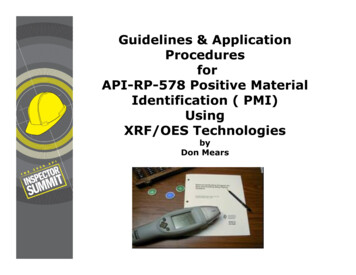
![API Ballot: [Ballot ID] – API 510 & API 570, Deferrals, Rev05](/img/5/api510andapi570deferralsrev5.jpg)
